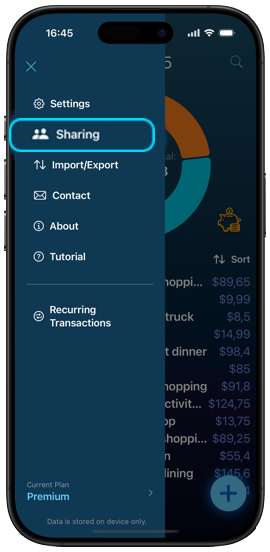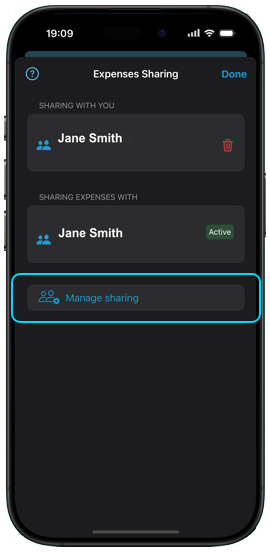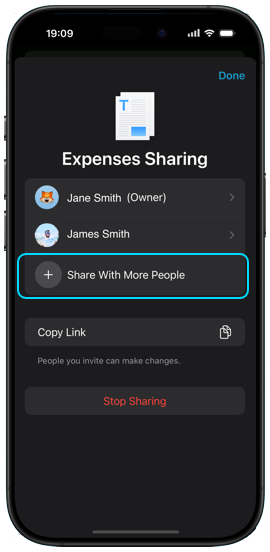Money conversations don't have to be awkward. When both partners have real-time visibility into family finances, those "Wait, how much did we spend on groceries?" moments disappear. Here's how to turn financial tracking into a team sport with Xpenses.
Why Couples Love Shared Financial Tracking
Imagine never having to ask "Did you pay the electric bill?" or "How much did you spend at Target?" again. With Xpenses family sharing, both partners see the complete financial picture in real-time. No more financial surprises, no more guesswork.
Real Talk: Many couple money fights aren't about the money itself, but about lack of communication and different spending awareness. Shared tracking fosters transparency and accountability, making it easier to address concerns before they escalate.
Setting Up Sharing (5 minutes)
Getting started is quite simple. Here's the step-by-step process:
- Open the side menu - Tap the three dashes (≡) in the top left corner
- Tap 👥 Sharing - This opens your sharing control center


- Tap "Manage Sharing" - Here you can add or remove people who access your data
- Send an invitation from each device - The easiest way is through iMessage (both people need iCloud accounts)
- Accept on both devices - Once accepted, you'll both see shared transactions instantly

Note: Sharing is "directional", meaning when you send an invitation to share, you will be sharing your data. To get access to the other person's data, they will need to send you an invitation from their device.
Pro Tip: The best time to set this up is when you're both together, so you can troubleshoot any issues immediately.
Need help? Tap the ? icon in the top left corner of the sharing menu for detailed setup guidance.
Privacy First
All sharing happens through Apple's secure iCloud system. Your data never touches our servers. It is privately stored in your own personal iCloud, encrypted and private.
Making It Work: The Daily Dance
The 30-Second Rule
The secret to successful shared tracking? Both partners commit to adding transactions within 30 seconds of making them. Waiting in line for coffee? Add it. Walking back to the car after grocery shopping? Add it. It becomes as automatic as checking your phone.
Bonus teamwork: While together, one partner can add the transaction while the other pays.
Who Tracks What?
With synced data you don't need to duplicate everything. Here are some natural divisions that work for many couples:
- Individual purchases: Each person tracks their own coffee, lunch, personal shopping
- Shared expenses: Whoever pays adds it (groceries, date nights, utilities)
- Big purchases: Discuss and add together, so you both see the category and amount
- Recurring items: Set these up once, and they'll auto-add for both of you
Turning Data into Conversations
The Monthly Money Date
Once a month, grab coffee (or wine) and spend 10 minutes reviewing your shared data together:
- Celebrate wins: "Look how much we saved on dining out this month!"
- Spot patterns: "Interesting, we spent more on groceries but less on takeout"
- Plan ahead: "Next month we have three birthdays. Let's budget for gifts"
- Adjust categories: "Should we split 'Fitness' into separate categories?"

Plot Twist: The couple that used to argue over "mystery charges" on their credit card statement? Now they high-five when they spot a spending pattern that helps them save for their dream vacation. Turns out, when you replace assumptions with actual data, financial conversations become way more fun. 🎉
Smart Strategies for Financial Harmony
The Category Agreement
Spend 5 minutes agreeing on how you'll categorize common expenses:
- Is Target a "Food & Groceries" or "Home" shopping trip? (Hint: it may help to split it when you buy both groceries and household items)
- Are work lunches "Food & Groceries > Dining Out" or a separate work expense category?
- Do dinners while traveling belong in "Food & Groceries > Dining Out" or should they be a part of "Vacation"?
The Budget Buddy System
If you decide to use budgeting features, create them together:
- Joint limits: Set family spending limits for categories like groceries or entertainment
- Individual fun money: Each person gets a personal spending category with their own limit
- Visual cues: Watch the piggy bank change colors together
Respecting Different Money Styles
One of you might be a detailed tracker, the other more big-picture. That's perfect! Here's how to make it work:
- Detail person: Tracks most transactions, sets up categories, manages recurring items
- Big picture person: Focuses on major purchases, reviews monthly data, handles budget conversations
- Both people: Commit to adding your own purchases promptly and staying curious (not judgmental) about spending patterns
Troubleshooting Common Challenges
"My Partner Forgets to Track Things"
Start with a gentle daily check-in: "Hey, want to do a quick Xpenses update together?" Make it collaborative, not confrontational. Many couples find that setting a phone reminder helps build the habit.

"We Disagree on Categories"
This is valuable information about how you each think about money. Have the conversation, then pick one approach and stick with it. Consistency matters more than perfection.
"The Numbers Make Me Anxious"
Remember: information is empowering, not shameful. Your spending patterns are just data that help you make intentional choices. Focus on trends and improvements, not perfection.
Advanced Family Features
Teaching Kids About Money
Show (age-appropriate) budget charts to older kids. It's a great way to explain why you can't buy everything they want and help them understand family financial priorities.
Planning Together
Use your historical data to plan for:
- Seasonal expenses: "We always spend more in December, let's save extra in November"
- Vacation budgets: "Based on our normal spending, we can afford $X for our trip"
- Big purchases: "If we reduce dining out by $Y, we can afford that new couch in Z months"
Managing Privacy Within Sharing
Even in committed relationships, personal financial space is healthy. Consider:
- Each person having a "personal spending" category for individual purchases
- Agreeing on spending limits where you don't need to discuss every purchase
Money as a Love Language
When couples track finances together thoughtfully, something beautiful happens: money becomes a tool for partnership instead of a source of conflict. You start making decisions as a team, celebrating financial wins together, and supporting each other through challenges.
Shared financial tracking isn't about control or judgment. It's about transparency, teamwork, and building the life you want together. With Xpenses, you have the control, simplicity, and real-time collaboration to make it work.
Here's to your financial partnership! 💑💰

